初二英语教学设计
- 格式:doc
- 大小:191.00 KB
- 文档页数:15
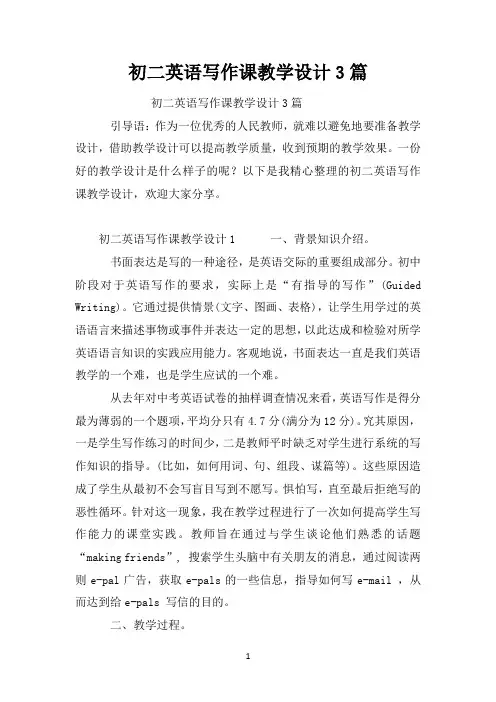
初二英语写作课教学设计3篇初二英语写作课教学设计3篇引导语:作为一位优秀的人民教师,就难以避免地要准备教学设计,借助教学设计可以提高教学质量,收到预期的教学效果。
一份好的教学设计是什么样子的呢?以下是我精心整理的初二英语写作课教学设计,欢迎大家分享。
初二英语写作课教学设计1 一、背景知识介绍。
书面表达是写的一种途径,是英语交际的重要组成部分。
初中阶段对于英语写作的要求,实际上是“有指导的写作”(Guided Writing)。
它通过提供情景(文字、图画、表格),让学生用学过的英语语言来描述事物或事件并表达一定的思想,以此达成和检验对所学英语语言知识的实践应用能力。
客观地说,书面表达一直是我们英语教学的一个难,也是学生应试的一个难。
从去年对中考英语试卷的抽样调查情况来看,英语写作是得分最为薄弱的一个题项,平均分只有4.7分(满分为12分)。
究其原因,一是学生写作练习的时间少,二是教师平时缺乏对学生进行系统的写作知识的指导。
(比如,如何用词、句、组段、谋篇等)。
这些原因造成了学生从最初不会写盲目写到不愿写。
惧怕写,直至最后拒绝写的恶性循环。
针对这一现象,我在教学过程进行了一次如何提高学生写作能力的课堂实践。
教师旨在通过与学生谈论他们熟悉的话题“making friends”, 搜索学生头脑中有关朋友的消息,通过阅读两则e-pal广告,获取e-pals的一些信息,指导如何写e-mail ,从而达到给e-pals 写信的目的。
二、教学过程。
1.Warm-up活动:通过听一首英语歌:“The more we get together, the happier well be.”目的是活跃气氛,为引出今天的话题做准备。
2.Revision①使用大脑风暴法(brainstorm)让学生想出一些和friends 有关的单词短语和句子,目的是激活学生头脑中和写作话题make friends 相关的东西,如想法、概念、形象等酝酿写作的思路,供拟稿阶段(drafting stage)选择有写的价值和意义的东西时参考。
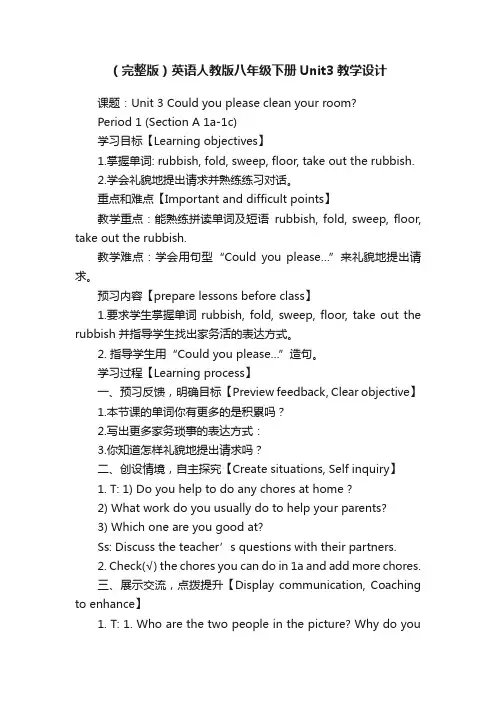
(完整版)英语人教版八年级下册Unit3教学设计课题:Unit 3 Could you please clean your room?Period 1 (Section A 1a-1c)学习目标【Learning objectives】1.掌握单词: rubbish, fold, sweep, floor, take out the rubbish.2.学会礼貌地提出请求并熟练练习对话。
重点和难点【Important and difficult points】教学重点:能熟练拼读单词及短语rubbish, fold, sweep, floor, take out the rubbish.教学难点:学会用句型“Could you please…”来礼貌地提出请求。
预习内容【prepare lessons before class】1.要求学生掌握单词rubbish, fold, sweep, floor, take out the rubbish并指导学生找出家务活的表达方式。
2. 指导学生用“Could you please…”造句。
学习过程【Learning process】一、预习反馈,明确目标【Preview feedback, Clear objective】1.本节课的单词你有更多的是积累吗?2.写出更多家务琐事的表达方式:3.你知道怎样礼貌地提出请求吗?二、创设情境,自主探究【Create situations, Self inquiry】1. T: 1) Do you help to do any chores at home ?2) What work do you usually do to help your parents?3) Which one are you good at?Ss: Discuss the teacher’s questions with their partners.2. Check(√) the chores you can do in 1a and add more chores.三、展示交流,点拨提升【Display communication, Coaching to enhance】1. T: 1. Who are the two people in the picture? Why do yousay so?2. Where are they? How do you know?2. Read the chores and add more chores.3. Use “Could you please…” to make a conversation just like Peter and his mother. 1c.4. Listen to 1b and check their answers.四、师生互动,拓展延伸【Teacher-student interaction, Development】【归纳】Make polite requests. ------ Could you please…? Yes, sure./ OK, but……【拓展】1.Can you do some dishes?2. rubbish的同义词:eg. You do talk rubbish sometimes. 胡言乱语【辨析】1. do 与make2. clean 与sweepeg. Let’s clean the house. You sweep the floor and I wash the dishes.五、达标测评, 巩固提高【Evaluation standards,Consolidation and improvement】基础题I. 根据句意及首字母提示写出单词。
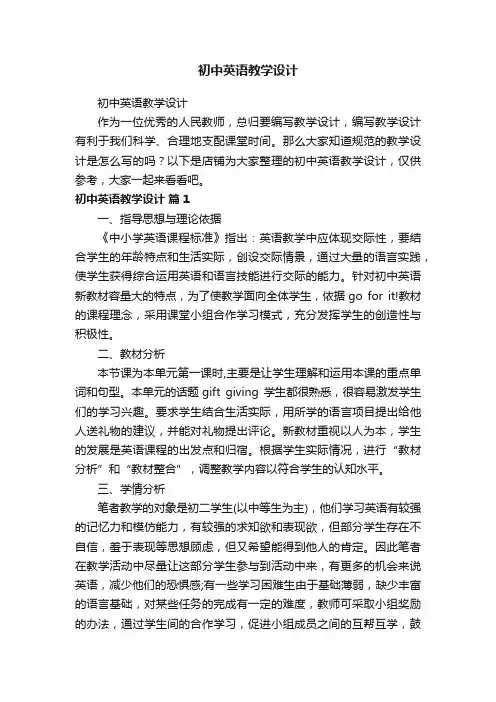
初中英语教学设计初中英语教学设计作为一位优秀的人民教师,总归要编写教学设计,编写教学设计有利于我们科学、合理地支配课堂时间。
那么大家知道规范的教学设计是怎么写的吗?以下是店铺为大家整理的初中英语教学设计,仅供参考,大家一起来看看吧。
初中英语教学设计篇1一、指导思想与理论依据《中小学英语课程标准》指出:英语教学中应体现交际性,要结合学生的年龄特点和生活实际,创设交际情景,通过大量的语言实践,使学生获得综合运用英语和语言技能进行交际的能力。
针对初中英语新教材容量大的特点,为了使教学面向全体学生,依据go for it!教材的课程理念,采用课堂小组合作学习模式,充分发挥学生的创造性与积极性。
二、教材分析本节课为本单元第一课时,主要是让学生理解和运用本课的重点单词和句型。
本单元的话题gift giving 学生都很熟悉,很容易激发学生们的学习兴趣。
要求学生结合生活实际,用所学的语言项目提出给他人送礼物的建议,并能对礼物提出评论。
新教材重视以人为本,学生的发展是英语课程的出发点和归宿。
根据学生实际情况,进行“教材分析”和“教材整合”,调整教学内容以符合学生的认知水平。
三、学情分析笔者教学的对象是初二学生(以中等生为主),他们学习英语有较强的记忆力和模仿能力,有较强的求知欲和表现欲,但部分学生存在不自信,羞于表现等思想顾虑,但又希望能得到他人的肯定。
因此笔者在教学活动中尽量让这部分学生参与到活动中来,有更多的机会来说英语,减少他们的恐惧感;有一些学习困难生由于基础薄弱,缺少丰富的语言基础,对某些任务的完成有一定的难度,教师可采取小组奖励的办法,通过学生间的合作学习,促进小组成员之间的互帮互学,鼓励小组中的优秀成员主动帮助学习困难生,培养学生的团队意识。
提高他们综合运用语言的能力,让他们都能体验到成功的喜悦,使各层次的学生都有所收获。
四、教学目标(1)语言知识目标:引导学生掌握本单元相关的词汇和句型。
(2)语言技能目标:能用所学的语言项目给对方提出建议和意见。
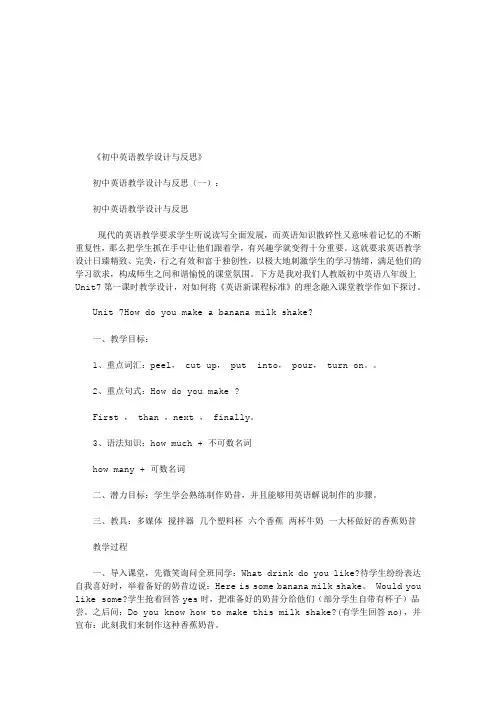
《初中英语教学设计与反思》初中英语教学设计与反思(一):初中英语教学设计与反思现代的英语教学要求学生听说读写全面发展,而英语知识散碎性又意味着记忆的不断重复性,那么把学生抓在手中让他们跟着学,有兴趣学就变得十分重要。
这就要求英语教学设计日臻精致、完美,行之有效和富于独创性,以极大地刺激学生的学习情绪,满足他们的学习欲求,构成师生之间和谐愉悦的课堂氛围。
下方是我对我们人教版初中英语八年级上Unit7第一课时教学设计,对如何将《英语新课程标准》的理念融入课堂教学作如下探讨。
Unit 7How do you make a banana milk shake?一、教学目标:1、重点词汇:peel, cut up, put into, pour, turn on。
2、重点句式:How do you make ?First , than ,next , finally。
3、语法知识:how much + 不可数名词how many + 可数名词二、潜力目标:学生学会熟练制作奶昔,并且能够用英语解说制作的步骤。
三、教具:多媒体搅拌器几个塑料杯六个香蕉两杯牛奶一大杯做好的香蕉奶昔教学过程一、导入课堂,先微笑询问全班同学:What drink do you like?待学生纷纷表达自我喜好时,举着备好的奶昔边说:Here is some banana milk shake。
Would you like some?学生抢着回答yes时,把准备好的奶昔分给他们(部分学生自带有杯子)品尝。
之后问:Do you know how to make this milk shake?(有学生回答no),并宣布:此刻我们来制作这种香蕉奶昔。
二、教学make a banana milk shake1、播放图片,让学生观看并说出制作奶昔所需工具和物品(必要教师时帮忙补充)。
顺势学习搅拌器(biender)这个单词。
2、播放制作香蕉奶昔全过程,结合学习关键词汇:peel, cut up, put into,pour, turn on。
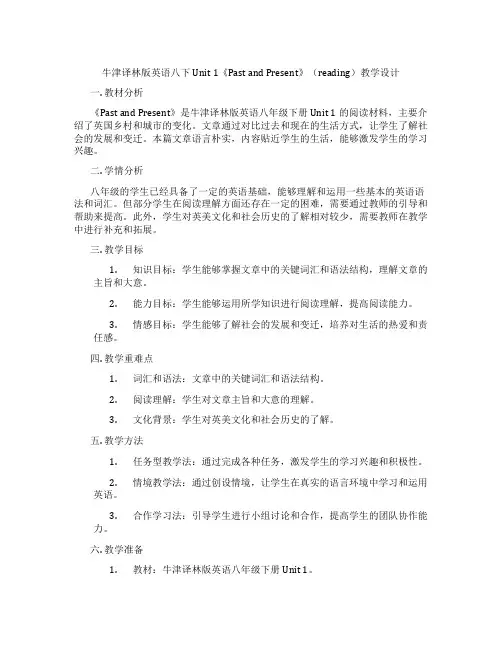
牛津译林版英语八下Unit 1《Past and Present》(reading)教学设计一. 教材分析《Past and Present》是牛津译林版英语八年级下册Unit 1的阅读材料,主要介绍了英国乡村和城市的变化。
文章通过对比过去和现在的生活方式,让学生了解社会的发展和变迁。
本篇文章语言朴实,内容贴近学生的生活,能够激发学生的学习兴趣。
二. 学情分析八年级的学生已经具备了一定的英语基础,能够理解和运用一些基本的英语语法和词汇。
但部分学生在阅读理解方面还存在一定的困难,需要通过教师的引导和帮助来提高。
此外,学生对英美文化和社会历史的了解相对较少,需要教师在教学中进行补充和拓展。
三. 教学目标1.知识目标:学生能够掌握文章中的关键词汇和语法结构,理解文章的主旨和大意。
2.能力目标:学生能够运用所学知识进行阅读理解,提高阅读能力。
3.情感目标:学生能够了解社会的发展和变迁,培养对生活的热爱和责任感。
四. 教学重难点1.词汇和语法:文章中的关键词汇和语法结构。
2.阅读理解:学生对文章主旨和大意的理解。
3.文化背景:学生对英美文化和社会历史的了解。
五. 教学方法1.任务型教学法:通过完成各种任务,激发学生的学习兴趣和积极性。
2.情境教学法:通过创设情境,让学生在真实的语言环境中学习和运用英语。
3.合作学习法:引导学生进行小组讨论和合作,提高学生的团队协作能力。
六. 教学准备1.教材:牛津译林版英语八年级下册Unit 1。
2.多媒体设备:电脑、投影仪、音响等。
3.教学素材:与文章相关的图片、视频、阅读材料等。
4.作业布置:布置预习任务,让学生提前熟悉文章内容。
七. 教学过程1.导入(5分钟)利用多媒体展示英国乡村和城市的图片,引导学生谈论过去和现在的生活变化。
提问学生:“你们认为过去和现在的生活有什么不同?”、“你们对未来有什么期待?”等,激发学生的学习兴趣。
2.呈现(10分钟)教师简要介绍文章的主旨和大意,然后让学生阅读文章,注意理解文章中的关键词汇和语法结构。
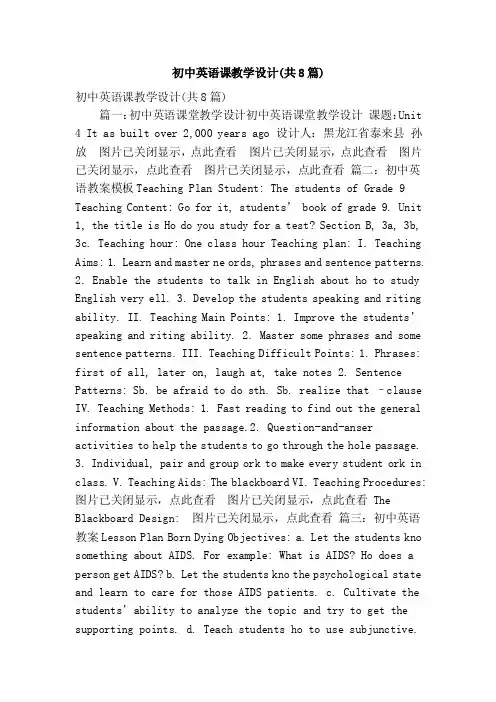
初中英语课教学设计(共8篇)初中英语课教学设计(共8篇)篇一:初中英语课堂教学设计初中英语课堂教学设计课题:Unit 4 It as built over 2,000 years ago 设计人:黑龙江省泰来县孙放图片已关闭显示,点此查看图片已关闭显示,点此查看图片已关闭显示,点此查看图片已关闭显示,点此查看篇二:初中英语教案模板Teaching Plan Student: The students of Grade 9 Teaching Content: Go for it, students’ book of grade 9. Unit 1, the title is Ho do you study for a test? Section B, 3a, 3b,3c. Teaching hour: One class hour Teaching plan: I. Teaching Aims: 1. Learn and master ne ords, phrases and sentence patterns.2. Enable the students to talk in English about ho to study English very ell.3. Develop the students speaking and riting ability. II. Teaching Main Points: 1. Improve the students’ speaking and riting ability. 2. Master some phrases and some sentence patterns. III. Teaching Difficult Points: 1. Phrases: first of all, later on, laugh at, take notes 2. Sentence Patterns: Sb. be afraid to do sth. Sb. realize that –clause IV. Teaching Methods: 1. Fast reading to find out the general information about the passage.2. Question-and-anseractivities to help the students to go through the hole passage.3. Individual, pair and group ork to make every student ork in class. V. Teaching Aids: The blackboard VI. Teaching Procedures: 图片已关闭显示,点此查看图片已关闭显示,点此查看 The Blackboard Design: 图片已关闭显示,点此查看篇三:初中英语教案Lesson Plan Born Dying Objectives: a. Let the students kno something about AIDS. For example: What is AIDS? Ho does a person get AIDS? b. Let the students kno the psychological state and learn to care for those AIDS patients. c. Cultivate the students’ability to analyze the topic a nd try to get the supporting points. d. Teach students ho to use subjunctive.Important Points/Grammar: a. Cultivate the students’ability to analyze the topic and try to get the supporting points. b. Let the students kno those AIDS patients’ psychological state and learn to care for them. c. Teach subjunctive. d. ne ords and phrases:immune system;be inflected ith; survive; suffer from; cheer up; available; persuade. Teaching aids: Pictures, slides, pieces of paper ith different tasks on Procedure Warm-up/Lead-in Activities: Hold a general knoledge test in class by asking some questions related to AIDS, such as hat’s the date of orld AIDS DAY? What’s AIDS? Ho do people get AIDS? What’s the symbol of it? And so on,to stimulate students’ enthusiasm. Stage1, Reading: a. Involve students in reading the text to get familiar ith the content. b. After finishing reading, ask students five questions: 1. What’s AIDS? 2. Ho do people get AIDS? 3. What kind of life does Xiaohua live? 4. What do the AIDS patients suffer from? 5. If you have got ADIS, ho ould you live your rest life? c. Teach students the to important reading methods: skimming and scanning. Then, ask them to read the text once again by using skimming to find the main idea of the text and using scanning to find more specific information of this text.d. After reading, let them present their on ansers of these five questions. Stage 2, Text Explaining: Divide the hole class into 7 groups, every group focuses on one paragraph and finds out the important information hich supports the text. At first, ment the anser of every group. Then explain the text systematically. The text consists of some information as follos: Para1: Xiaohua is?; she is? Para2: AIDS is a disease \ breaks don \ leave \defenseless Para3: via unprotected sex; infected blood transfusion or through birth Para4: Children infect \ the young suffer Para5: not discouraged \ encourage visit \ support \ cheer up \Telling \ encouraging \ creating Para6: Disease\fear \ ignorance \ misunderstanding Para7: “M y life may have to be short, but there is no reason hy itcan’t be beautiful” Introduce to students hat subjunctive is. Then ask students to find out the sentences hich contain subjunctive. The sentences are: 1. I ish my mum ere here ith me and that e eren’t’t sick.2. If I ere to live long enough to have a job, I ould choose to be a doctor, helping these AIDS patients.3. I ish people ould find out the facts and not act as if I ere a bad or dangerous person.4. If I ere you, I ould give an AIDS patient a hug. Stage3, Oral English Practice: First, Let students talk about their dreams about future in small groups by using subjunctive. Then, every group assigns a representative to share his dreams ith the hole class. Stage4, Production: Guided, Meaningful Production Written ork: Ask students to pretend to be Xiaohua’s friends. According to the content of the text, everyone rites a short letter to Xiaohua for greeting. Students are directed to use at least some examples of the structures ithin the text. Then, pick out the best one and read it in front of the students. Homeork: Assign students supplementary reading to practice subjunctive in real context. Assessment.初中英语教学设计 Teaching Aims and Demands: nguage knoledge: Key vocabulary: dining, hall, gym, science, lab, in front of, next, behind, any, one, building Key structure: there be … 2. Reading skill: Teaching Procedures: 教师事先藏好自己的几样东西,上课时假装找不到(注意这时教师要使用丰富的体态语言和脸部表情,让学生感觉到这是真实的),这样就自然地呈现了新的句型:Where is….? It’s on / on / in / in front of / behind / next to… Where are …? They’re on / in / in front of / behind / next to… 设计意图:通过设置让学生帮老师找东西这样一个真实的场景来导入新课,能够立刻调动起学生的参与性,启动学习的发生。
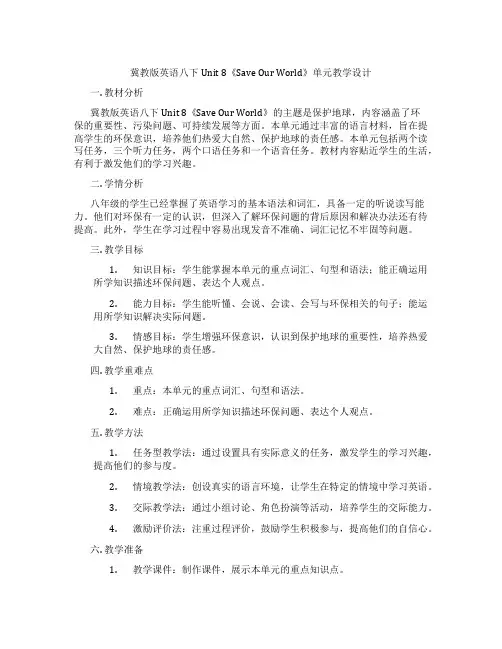
冀教版英语八下Unit 8《Save Our World》单元教学设计一. 教材分析冀教版英语八下Unit 8《Save Our World》的主题是保护地球,内容涵盖了环保的重要性、污染问题、可持续发展等方面。
本单元通过丰富的语言材料,旨在提高学生的环保意识,培养他们热爱大自然、保护地球的责任感。
本单元包括两个读写任务,三个听力任务,两个口语任务和一个语音任务。
教材内容贴近学生的生活,有利于激发他们的学习兴趣。
二. 学情分析八年级的学生已经掌握了英语学习的基本语法和词汇,具备一定的听说读写能力。
他们对环保有一定的认识,但深入了解环保问题的背后原因和解决办法还有待提高。
此外,学生在学习过程中容易出现发音不准确、词汇记忆不牢固等问题。
三. 教学目标1.知识目标:学生能掌握本单元的重点词汇、句型和语法;能正确运用所学知识描述环保问题、表达个人观点。
2.能力目标:学生能听懂、会说、会读、会写与环保相关的句子;能运用所学知识解决实际问题。
3.情感目标:学生增强环保意识,认识到保护地球的重要性,培养热爱大自然、保护地球的责任感。
四. 教学重难点1.重点:本单元的重点词汇、句型和语法。
2.难点:正确运用所学知识描述环保问题、表达个人观点。
五. 教学方法1.任务型教学法:通过设置具有实际意义的任务,激发学生的学习兴趣,提高他们的参与度。
2.情境教学法:创设真实的语言环境,让学生在特定的情境中学习英语。
3.交际教学法:通过小组讨论、角色扮演等活动,培养学生的交际能力。
4.激励评价法:注重过程评价,鼓励学生积极参与,提高他们的自信心。
六. 教学准备1.教学课件:制作课件,展示本单元的重点知识点。
2.教学素材:收集与环保相关的图片、视频、文章等素材。
3.教学设备:投影仪、计算机、音响等设备。
4.分组安排:将学生分成若干小组,便于开展小组活动。
七. 教学过程1.导入(5分钟)利用投影仪展示地球污染的图片,引导学生关注环保问题。
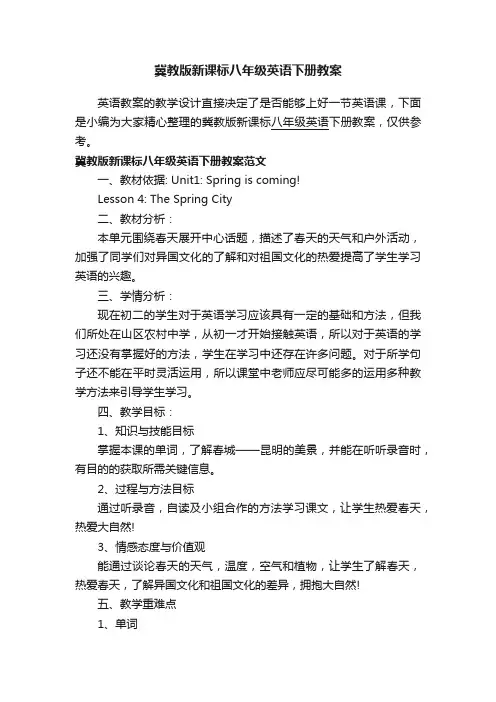
冀教版新课标八年级英语下册教案英语教案的教学设计直接决定了是否能够上好一节英语课,下面是小编为大家精心整理的冀教版新课标八年级英语下册教案,仅供参考。
冀教版新课标八年级英语下册教案范文一、教材依据: Unit1: Spring is coming!Lesson 4: The Spring City二、教材分析:本单元围绕春天展开中心话题,描述了春天的天气和户外活动,加强了同学们对异国文化的了解和对祖国文化的热爱提高了学生学习英语的兴趣。
三、学情分析:现在初二的学生对于英语学习应该具有一定的基础和方法,但我们所处在山区农村中学,从初一才开始接触英语,所以对于英语的学习还没有掌握好的方法,学生在学习中还存在许多问题。
对于所学句子还不能在平时灵活运用,所以课堂中老师应尽可能多的运用多种教学方法来引导学生学习。
四、教学目标:1、知识与技能目标掌握本课的单词,了解春城——昆明的美景,并能在听听录音时,有目的的获取所需关键信息。
2、过程与方法目标通过听录音,自读及小组合作的方法学习课文,让学生热爱春天,热爱大自然!3、情感态度与价值观能通过谈论春天的天气,温度,空气和植物,让学生了解春天,热爱春天,了解异国文化和祖国文化的差异,拥抱大自然!五、教学重难点1、单词2、短语及语法六、教法与学法小组讨论、合作探究、教师指导七、课型新授八、教学过程Step 1.Lead-inA warming-upA sayingStep 2.pictures show and new words, then, listeningShow some pictures about spring and learn the new words by playing a game, the do the listening about the text and answer one simple question.What is the spring city?It’s Kunming.Step 3.ReadingAsk several students to read the text and pay attention to the new words, the students read it again, and discuss together about the four questions in “Let’s Do It.part1”Step 4. ListeningDo the listening in “Let’s Do It!”part2, listen to it twice, and then invite some students to answer them.Step 5.DiscussingDivide the class into small groups; write the following words on the blackboard:Air /weather/ plants/ and outdoor activities.Step nguage points1. feel like /sound like / smell like / taste likefeel like doing sth.2. because and because ofBecause +句子Because of + n./pron./doing3. hundreds of /基数词+单位名词(hundred /thousand/million/billion)4. think of =consider5. all over the world =around the world6. all year round7. plenty of=a lot of =lots of8. long for= look forward toStep 6.Homework1、Write a short passage about spring in your hometown2、Preview Lesson 5Step 7.Summary:Review the text is very important. The students know what they will take to the class, what is useful to the study. Let them to talk about The Spring City. --- Its air, weather, plants and the outdoor activities in spring.九、板书设计:Lesson 4: The Spring CityAir weather plants and the outdoor activities十、教学反思:本节课在前几节课学习的基础上进一步来学习春天,通过运用多媒体向学生展示了春天的景色。
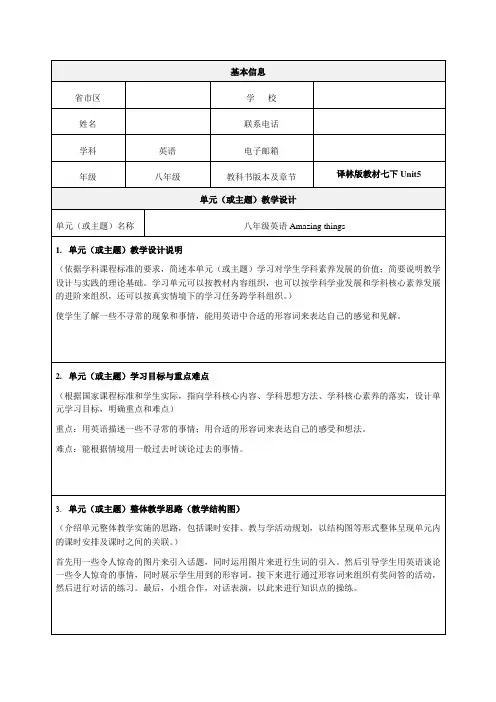
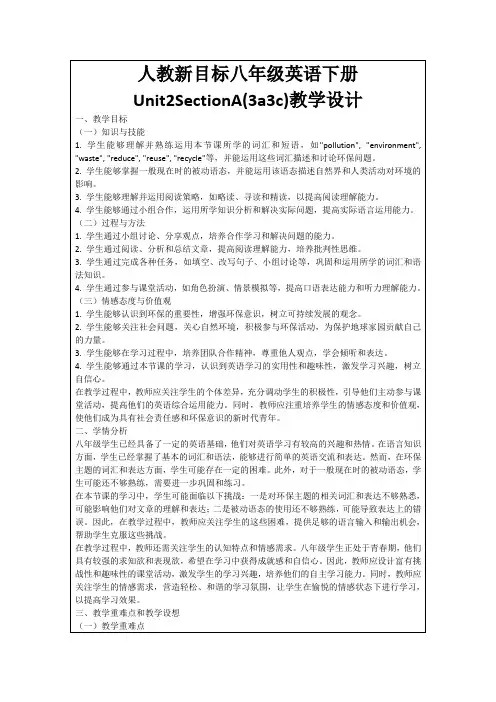
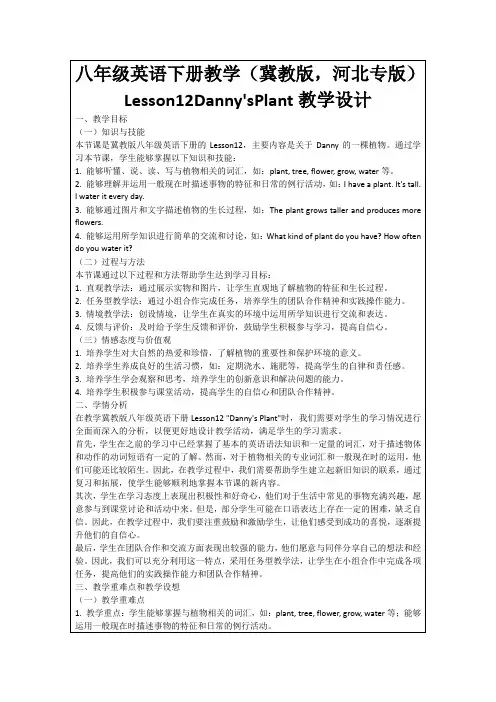
新人教版八年级下册初中英语全册教案(教学设计)一. 教学目标本教案旨在帮助八年级学生掌握下册初中英语的相关知识和技能,包括听、说、读、写四个方面的能力提高。
二. 教学内容本教案涵盖了全册的教学内容,包括以下单元和主要教学点:1. Unit 1: Meeting New Friends- 语言点:be动词的一般现在时- 活动:介绍新朋友- 阅读:了解文化差异2. Unit 2: The First Day at School- 语言点:一般过去时- 活动:描述第一天上学的经历- 阅读:理解校园规则3. Unit 3: I Love Reading- 语言点:情态动词can和must - 活动:介绍喜欢的书籍- 阅读:阅读理解4. Unit 4: My School Life- 语言点:形容词比较级和最高级- 活动:描述学校生活的不同方面- 阅读:了解不同的学校生活5. Unit 5: Our Future Jobs- 语言点:职业相关词汇- 活动:谈论未来的职业- 阅读:了解不同的职业6. Unit 6: Weather and Climate- 语言点:天气相关词汇和短语- 活动:讨论天气和气候- 阅读:了解不同地区的气候7. Unit 7: Enjoy Your Trip- 语言点:旅行相关词汇和短语- 活动:计划和描述旅行- 阅读:阅读旅行指南8. Unit 8: At the Farm- 语言点:动词的现在进行时- 活动:描述在农场的经历- 阅读:了解农场生活三. 教学方法本教案使用多种教学方法,包括但不限于:听力练、口语对话、阅读理解、小组讨论、写作练等。
教师将根据具体情况选择合适的教学方法进行教学。
四. 教学步骤1. 引入新课,激发学生兴趣。
2. 执行听力练以提高学生听力能力。
3. 进行口语对话练,帮助学生提高口语表达能力。
4. 进行阅读理解练,加深学生对课文的理解。
5. 进行小组讨论,让学生互相交流观点。
初二英语《语法专项复习—名词》优质课教案教学设计教材分析:本课所复习梳理的内容主要关于名词的分类,可数名词的复数变化规则,名词做主语与谓语的单复数一致及名词的所有格。
由几个猜谜语引出对名词的探讨,接下来通过几个循序渐进的练习活动引导学生归纳梳理名词各部分知识。
内容比较容易引起学生的好奇心,吸引学生参与到合作、讨论等教学活动中来。
学情分析:初二学生已经学习过名词各部分知识,在接受上不会有难度,这就要求教师通过对学生的检测,来明确他们的知识漏洞,进行梳理,帮助学生把名词该项知识应用到实际运用中。
语言知识目标:1、名词的分类、可数名词的复数变化、名词作主语时与谓语单复数一致及名词所有格。
2、名词的用法语言技能目标:1、能通过练习进行归纳,巩固名词各项用法。
2、通过复习掌握名词的各种用法,培养学生运用;2、名词作主语时与谓语单复数一致;3、名词所有格的用法。
教学难点:掌握名词的各种用法并能准确运用名词教学方法与手段:主要运用归纳法、小组合作,同时整堂课穿插竞赛机制,鼓励学生积极参与到小组合作中。
在教学中充分运用多媒体辅助教学手段,加大课堂密度,增强教学效果。
教学过程:Step 1: Lead in : GreetingsGuessing game:Teacher shows Ss some sentences and asks them in pairs to guessthe nouns1)What kind of table has no legs?2)What man can’t live inside the house?3)What day is the strongest in a week?4)What kind of drink has no color, no shapes, no taste and nosmell?(设计意图)通过俩俩合作猜单词谜语,激发学生用英语思考,调动小组竞争的积极性,为下面进入名词的分类做好铺垫。
八年级英语上册-人教版-Unit 6 教学设计一. 教材分析人教版八年级英语上册Unit 6的主题是关于描述过去发生的事情。
通过本单元的学习,学生能够掌握一般过去时的用法,学会如何用英语描述过去发生的事情。
教材内容丰富,包括听、说、读、写等多个方面,旨在全面提高学生的英语能力。
二. 学情分析八年级的学生已经掌握了英语学习的基本语法和词汇,具备一定的听、说、读、写能力。
但部分学生对过去时的用法还不够熟练,需要通过本节课的教学来进一步巩固。
此外,学生在描述过去事件时,可能会存在表达不清、时态错误等问题,需要教师在教学中加以引导和纠正。
三. 教学目标1.知识目标:学生能够掌握一般过去时的构成和用法,学会如何用英语描述过去发生的事情。
2.能力目标:学生能够在实际情境中运用过去时进行交流,提高听、说、读、写的能力。
3.情感目标:培养学生对英语学习的兴趣,激发学生积极参与课堂活动的热情。
四. 教学重难点1.重点:一般过去时的构成和用法。
2.难点:如何正确运用过去时描述过去发生的事情,并在实际情境中进行交流。
五. 教学方法1.情境教学法:通过设置各种真实的场景,让学生在实际语境中学习并运用过去时。
2.任务型教学法:通过完成各种任务,激发学生的学习兴趣,提高学生的参与度。
3.交际式教学法:鼓励学生积极参与课堂交流,提高学生的听说能力。
六. 教学准备1.教师准备:准备好相关的教学材料,如PPT、图片、视频等。
2.学生准备:预习本节课的内容,了解一般过去时的基本用法。
七. 教学过程1.导入(5分钟)教师通过提问引导学生回顾过去时的一般疑问句和回答方式,激发学生的学习兴趣。
2.呈现(10分钟)教师展示PPT,呈现本节课的主要内容,包括一般过去时的构成、用法以及相关词汇。
同时,教师可以通过图片、视频等材料,为学生提供直观的感官体验,帮助学生更好地理解和记忆。
3.操练(10分钟)教师学生进行小组活动,让学生用过去时描述发生在小组成员之间的故事。
人教版八年级英语下册第二单元(同步教学设计)Unit 2 I’ll help to clean up the city park.Unit 2 I’ll help to clean up the city parks.Unit 2 I’ll help to clean up the city parks.Unit 2 I’ll help to clean up the city parks.Unit 2 I’ll help to clean up the city parks.2. disabled(adj.)有残疾的We should help the disabled children.3. difference(n.)差别There are some differences between my brother and me.4. imagine(v.)想象Can you imagine what’s in it?5. difficulties(n.)困难Are you having any difficulties?6. normal(adj.)正常的It’s normal to feel nervous before an exam.7. training(n.)训练They haven’t finished training.8. kindness(n.)仁慈Thank you for your kindness.3. Mark T(True)or F(False)according to the passage.(1) The writer can't use her arms or legs well. (T)(2) Lucky was brought to the writer by her friend. (F)(3) They have been trained at “Animal helpers” for seven months. (F)(4) A doghelper is for those who are disabled. (T)(5) Lucky can understand different orders.(T)【设计意图】通过细节练习,锻炼学生抓取信息、分辨信息的能力,同时训练学生的综合阅读能力。
新目标八年级英语(下)Unit8 Why don’t you get her a scarf?教学设计 一、教学内容及分析 本单元围绕“谈论和比较不同的东西和事情”这个话题,进一步为学习用现在完成时描述事件而设计了相关的语言情境。Section A 1—2c呈现了本单元的重点语法现象—如何给别人提出意见和建议,然后设计了听力活动、俩俩结对活动,从听、说角度训练了本单元的核心句型,并在Grammar Focus中进行了归纳总结。Section A3a—4所设计的活动,学生运用信息沟通的方法展开俩俩结对和小组活动,提供扩大词汇和训练核心句型的机会,运用自己的经验来谈论如何“送礼物”,进一步提高了交际技能。
SectionB1Aa-2b边循环Section A中出现的语言目标,变介绍新的词汇。然后,设计了两个听力活动,分别从两个层面,从宏观到细节帮助学生学习如何比较不同的东西和事情。SectionB2c-4设计的活动,则通过听、说读与写的活动,谈论做宠物的动物,对学生谈论
和比较不同的东西的能力进行了综合训练,首先帮助学生形成创造性地运用所学语言的能力。补充阅读文章告诉我们,由于北京深奥成功,全国又掀起了一场学习英语的热潮,文章
以一句问句作为标题,给我们提出了学习英语的方法——唱英语歌。
二、教学目标(三维目标) 1、知识与技能 本单元重点词汇:suggestion comment album guy spider mouse hamster turtle child pig advantage disadvantage rabbit company present bench stage winner Spokesperson progress statement 本单元重点句型: (1)What should I get sb? (2)Why don’get /buy sb.sth.? (3)What/How about sth.? (4)It’s / They’re too +adj (5) Present perfect tense^(6)掌握如何表达给别人买什么礼物。掌握如何建议为别人买礼物的表达方法。掌握如何比较物品的质量。通过学习如何赠送礼物,对比中西方文化的不同。 2、过程与方法 采用 “任务型”教学模式,首先把本单元的学习任务即学习掌握“送礼物”的表达方式告诉学生,在明确了学习任务后,老师提供为完成学习任务的过程中形成主动的学习状态,产生学习的欲望与动力。同时通过听力训练为主;第三课时集中词汇教学;第四 3、情感态度与价值观
通过询问为别人买什么礼物以及提出建议别人应该买什么礼物,达到了解、关心别人的目的,以此增进友谊。 三、教学重难点 1、重点
(1)What should I get sb? (2)Why don’get /buy sb.sth.? (3)What/How about sth.? (4)It’s / They’re too +adj (5) Present perfect tense 2、难点 (1)too +adj.意为“太……” (2)adj.+enough 意为“足够……” 四、教学关键 A.重点词汇名词:suggestion comment album guy spider mouse hamster
turtle child pig advantage disadvantage rabbit company present bench stage winner Spokesperson progress statement 动词:receive choose open enter encourage suggest drive 形容词:personal special pot-bellied trendy perfect clean asleep native modest earlier interested 词组:fall asleep, give away, hear of, an interest in, make friends with B.语言结构 What should I get my sister? Why don’t you get a camera? That’s too expensive. How about a watch? That’s too personal. Why don’t you buy a scarf? That’s not interesting enough. What should l get Lisa? How about a CD? No,that’s too cheap. What’s the best present you have ever received? C:语言功能。Compare qualities 五、教法选择与学法指导 根据《英语课标》和本单元教材内容,采用任务型语言教学途径,将教学目标设计成符合学生生活学习实际的任务链,尽量使学生在参与任务的过程中学习运用语言,形成语言能力,并使用多媒体辅助教学手段为学生学习营造较好的语言学习环境,提高学生学习语言的积极性。通过任务型的教学途径,发展学生的综合语言运用能力,使语言学习的过程成为学生形成积极的情感态度、主动思维和大胆实践、形成自主学习能力的过程。同时在教学中采用多媒体辅助教学、任务型教学模式,运用听说读写法,并以循序渐进的方式来进行教学。 六、课时及教学内容安排
教学内容 课时安排 教法选择 资源准备 教学评价 SectionA 1a—2c Period 1 小组合作学习
任务型教学 情景视听法 多媒体课件、教室及相关教学资源 观察 提问 激励 Section A 3a--4 Period 2 小组合作交际
任务型教学 情景视听法 多媒体课件、教室及相关教学资源 观察 提问 激励 互评 Section B 1a, 3a ,3b3c Period 3 任务型教学
阅读法 写作训练 多媒体课件、教室及相关教学资源 提问 谈话 互评 Section B 4 ,self check 1,2,just for fun Period 4 任务型教学
阅读法 归纳、整理法 写作训练 多媒体课件、教室及相关教学资源 提问 互评 小组评 检测 reading Period 5 阅读法 多媒体课件、教室及
相关教学资源 激励 提问 教学内容 SectionA 1a—2c 课时 Period 1 教学对象 八年级学生 执教者 一、教材内容分析 本节课主要学习:谈论礼品比较质量及对商品进行评论(Compare qualities and give advice),谈论应该给别人买什么礼物及建议为别人买什么礼物,学习如何赠送礼物,对比中西文化的差异。本节课的话题是谈论:赠送物品,比较质量。通过本节课学习学生们要掌握重点句型What should I get my mom for her birthday?
How about a scarf?并能熟练运用。为下一节课打下基础。 二、教学目标(知识,技能,情感态度与价值观) 1. Knowledge aims: ⑴.words: compare, gift, scarf, CD, bicycle, birthday, suggestion, comment, album, personal, special ⑵ Language points: ⑵ Language points: What should I get my mom for her birthday? How about a scarf? No, that’s too boring 2.Ability aims: ⑴ To train students’abilities of listening and speaking. ⑵ To train student’s communicative compare. 3. Emotion aims: To be able to help each other in communication. 三、重点、难点 重点:1. Words and expressions.2. Master the structures.3. Learn the language points.
难点:Make conversations using the structures in grammar 四、教法选择与学法指导 采用“任务型”教学,为学生设置真实的情景、语境,使学生在思考、交流、合作探究中学习和使 用语言。 五、资源准备 多媒体课件、教室及相关教学资源 六、教学过程 教学过程 教师活动 学生活动 设计意图
Task 1(5) Warm up 1.greeting the class 2.Show a calendar to the students 3.Ask ss questions just like:When is the Mother’s Day?
1.Look at the pictures. 2.Try to answer teacher’s questions
通过图片,引出本单元的话题,学生们就此谈论,母亲节给妈妈送什么礼物。
Task 2 Presentation Show some pictures and learn some new words. Ss look at the pictures and repeat after the teacher, then talk about the gifts.
通过图片,直观学习新词,并学会给出合适的评论。
Task 3 Finish off 1a
Show the problems and
discuss “Mother’s Day is coming” What should I get for her? Discuss which gifts are the best. 通过给妈妈送礼,让
学生感受的亲情。
Task 4 Ask for helping Show some different kinds of the gifts Ask the students give comments
通过寻求帮助的方
式联系巩固本单元重点句型
Task 5 Pairwork Get the Ss to make conversations like this: First practice and then